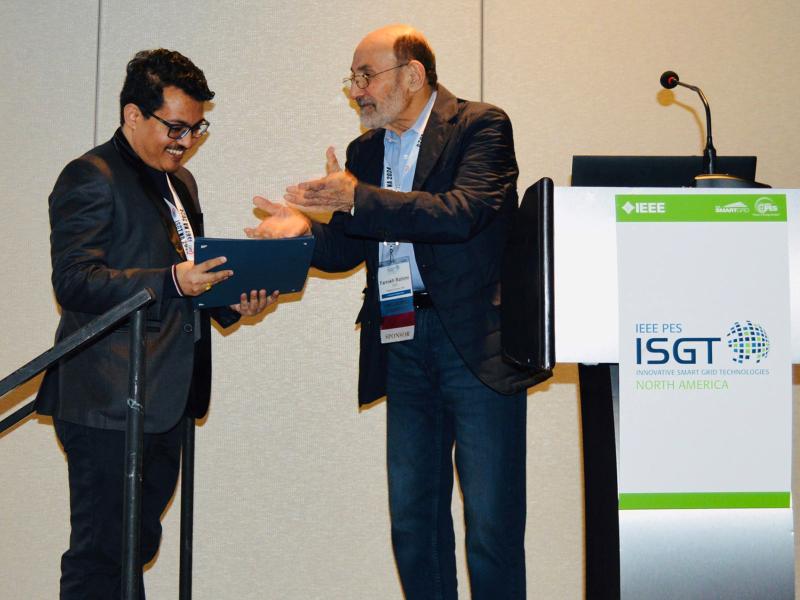
Grid Integration, Controls,
and Architecture
Grid Integration, Controls,
and Architecture
Understanding technical needs and
reaching the potential of storage technologies
Understanding technical needs and
reaching the potential of storage technologies
Grid integration, controls, and architecture at PNNL encompass the advanced communication technologies, planning tools, and operational models needed to adapt and optimize energy storage as part of an increasingly complex electric grid—today and into the future.
(Banner by Shannon Colson | Pacific Northwest National Laboratory)
The U.S. electric grid is the backbone of daily life and a thriving economy. The power industry responsible for this essential infrastructure faces the monumental task of adapting to an increasingly sophisticated energy system—including new energy storage technologies.
Pacific Northwest National Laboratory (PNNL) researchers are pioneering new models, including machine learning algorithms, to characterize and capture detailed storage technology performance as part of a modern electric grid. Our experts in power systems data, communications, and controls are working to integrate and optimize storage operations for the full range of grid benefits, such as availability and flexibility.

These efforts build on PNNL’s established leadership in piloting demonstration projects, developing new standards, and building grid architectures in support of the U.S. Department of Energy’s Office of Electricity, Office of Science, and Office of Energy Efficiency and Renewable Energy.
Integration for optimizing energy storage
Because grid-scale energy storage is a new technology, new integration techniques are necessary. PNNL works to simplify and standardize how storage is integrated into the grid, developing performance-informed tools to intelligently operate storage for the full suite of potential grid services—benefits beyond simply delivering energy. Our work in this area aims to optimize the way distributed energy resources are integrated into the grid to achieve efficiency and improve system resilience.
Integration relies heavily on control strategies and approaches for cost-effectiveness, as well as system modeling to address, for example, the role of control systems, protection systems, and energy storage systems in achieving resilience objectives. Integrating storage with conventional grid resources, such as generation plants, can also improve operational performance and flexibility.
PNNL works to develop capabilities that help the electric power industry achieve the desired impacts and values from storage and storage-supported grid assets. Our researchers have conducted hundreds of megawatt-hour storage projects with multiple utilities across the nation and developed the methods, capabilities, and tools for technology characterization, economic evaluation, and control strategy development. Our efforts routinely involve industry and regulatory collaborators—including electric utilities, system integrators, manufacturers, and other industry entities—to better understand the range of challenges they face and to test and validate solutions.
Next-generation controls and modeling characterization

Advancements in energy storage are critical to the resilience of the electric grid, our most complex machine.
Learn how the grid powers America
At PNNL, we connect cutting-edge fundamental scientists with end-use domain experts to discover and develop new energy storage technologies that can support reliable, affordable, and secure electric grid. PNNL launched the Grid Storage Launchpad, an innovation and testing facility to accelerate development, validation, and commercial readiness of storage systems for the power grid.
For transportation applications, we collaborate with researchers across the country on large energy storage initiatives. We lead national programs like the Battery 500 Consortium to improve energy storage for vehicles. The goal is to more than double the energy output per mass compared to existing batteries.
On-demand flexible power and energy capabilities provided by energy storage can bolster the grid in both normal and emergency situations. But practical challenges and limitations, such as the intricacies of real-time systems behavior, could be a substantial gap between the value anticipated and the value achieved. Proper deployment, including appropriate control and operational strategies, is crucial to assure the benefits of energy storage as envisioned during system planning and design.
We are also improving models to reflect complex energy storage characteristics at bulk power and distribution scales. For instance, we are collaborating with reliability planning entities to enhance energy storage system models across the three major planning models: steady-state, dynamic, and production cost models, just as conventional thermal and hydropower plants do.
New architecture to structure storage development
PNNL’s grid architecture leadership supports energy storage from asset control strategies to bulk energy storage utilization in networks. Grid architecture outlines the full potential for energy storage as core infrastructure to serve as a “shock absorber” missing from present-day grids. This approach can improve the grid’s operational flexibility, increase intrinsic grid resilience, and facilitate integration of microgrids and variable energy resources, such as wind and solar, while providing protection against both physical and cyber hazards.
Grid architecture points toward new control methods for not just individual storage devices but storage networks. Those networks could improve and extend grid dynamic control, increasing the effectiveness of all forms of generation and moving energy storage beyond its traditional role as a generation asset. New uses for storage on very fast time scales will require new research in storage technology and control systems to integrate energy storage as a key grid component that can and should be as fundamental as a transformer or circuit breaker.
Finally, our leadership in grid architecture is critical for developing co-simulation models that integrate power, communication, and transportation networks to help stakeholders make informed decisions about grid modernization, including energy storage. One such model is the advanced distribution system modeling, simulation, and management platform called the Hierarchical Engine for Large-scale Infrastructure Co-Simulation, or HELICS. The HELICS platform builds on the collective experience of multiple national laboratories and is designed to increase scalability and portability in modeling advanced features of highly integrated power and cyber-physical energy systems.
Grid modeling advancements
As the electric grid evolves with the increasingly distributed energy resources and changing electricity demand patterns, calculating resource schedules becomes more complex and the probability for error increases. At PNNL, our High-Performance Power Grid Optimization (HIPPO) software speeds up resource scheduling for system operators by up to 35 times more than current methods. The software uses machine learning to quickly deploy and adapt high-performance computing algorithms across multiple input systems.
PNNL’s high-performance computing capabilities support medium-scale to petascale grid analytics, moving toward exascale—a vision we are currently working on as part of the U.S. Department of Energy’s Exascale Computing Project. As with this effort, many key research advances come through collaboration with utilities, vendors, and other research institutions.
For example, we developed the dynamic contingency analysis tool (DCAT) in collaboration with Siemens Power Technologies International and the Electrical Power Research Institute. DCAT, an R&D 100 award-winning technology, is now available as an open research platform and methodology for simulating and predicting large-scale outages and identifying mitigation measures. Another PNNL intelligent real-time emergency control tool, TRAST, provides fast and effective control actions to system operators within seconds in response to large contingencies or extreme events on the grid.

